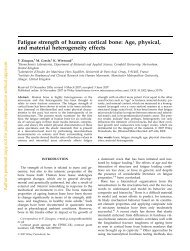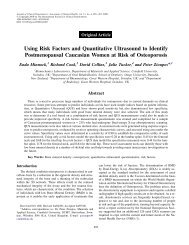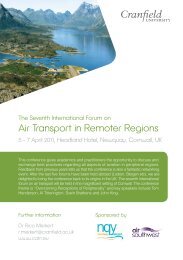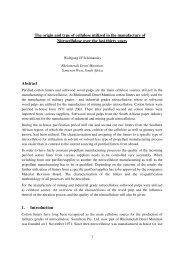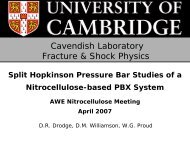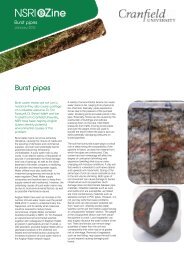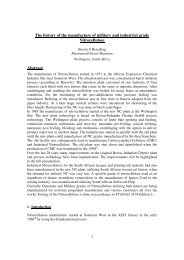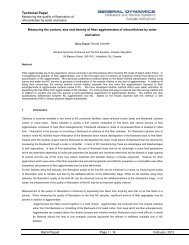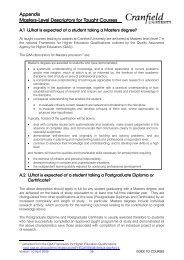Autumn 2002 PW 5 - Cranfield University
Autumn 2002 PW 5 - Cranfield University
Autumn 2002 PW 5 - Cranfield University
You also want an ePaper? Increase the reach of your titles
YUMPU automatically turns print PDFs into web optimized ePapers that Google loves.
NOSTALGIC FEATURE<br />
CHILBLAINS AND FROZEN PIPES<br />
Abercrombie Davidson<br />
“Our <strong>Cranfield</strong> days were an experience which neither my<br />
wife, Maud, nor I will ever forget,” writes‘Crombie’, as<br />
you will have known him...<br />
Married a year, it was the first time either of us had ever left<br />
our native S. Africa for any length of time – certainly the<br />
first time for a whole lot of other novelties, such as snow<br />
and living in a caravan.<br />
The motherly student affairs office had managed to reserve a<br />
caravan for us, an 18-footer with electricity laid on. The water<br />
supply was a hosepipe connected to a tap at the ‘Napier huts’ – a<br />
couple of disused prefabricated buildings. The only WC in the<br />
caravan was a bucket into which one poured ‘Elsanol’. These were<br />
emptied – preferably at night – into a loo behind the Napier huts.<br />
Living in a caravan in the snow was also a learning experience.<br />
Chilblains, ordering coal from the college to burn in the little stove<br />
in the caravan, and carrying water in a bucket, as the water pipe had<br />
frozen.<br />
Soon after arriving Maud found a job at the college shop. Then<br />
she found she was pregnant and, thus, had her first experience of<br />
the UK National Health Service. At first they tried to persuade her<br />
to have the baby at home but, when they found out our<br />
circumstances, reluctantly agreed on hospital. Lynette was<br />
premature and we rushed to Bedford General Hospital in the<br />
middle of the night. After the birth, Maud had to stay in hospital for<br />
10 days – the custom at the time. When she came home, Lynette’s<br />
‘evening colic’ made it impossible to study. The college took pity<br />
and gave me a study in Stringfellow Hall – seemingly the residence<br />
of choice for the Irish students, whose antics would turn your hair<br />
grey. I still have a mental picture of Maud typing lab reports with<br />
Lynette lying on her lap.<br />
After my first lecture I was in despair. Professor Ward, Head of<br />
Mathematics, gave no notes and lectured so fast it was impossible<br />
to make your own. I was convinced that the standard back in the<br />
colonies was so far behind that I would never pass but, to my relief,<br />
I found that all the students were in the same boat. We formed<br />
consortia to solve the tutorials he handed out.<br />
Some students, so the story goes, decided to register their dismay.<br />
They stood with a stretched blanket below the lecture room on the<br />
top floor of the Stafford Cripps building. One student suddenly<br />
College of Aeronautics 1959<br />
The caravan site, 1959<br />
stood up, and shouting: “I<br />
can’t stand this anymore!” ran<br />
to the window, opened it and<br />
launched himself into space.<br />
After the resulting chaos<br />
died down, Prof Ward, who<br />
had not moved from the<br />
Crombie (right) with Maud (bottom<br />
left) and some of his family when<br />
they visited <strong>Cranfield</strong>’s alumni office<br />
front of the classroom, merely requested: “Will somebody please<br />
close the window...”<br />
The students were always up to some prank. One night they<br />
disassembled a concrete mixer and reassembled it in the principal’s<br />
office; on dining-in night they pushed the Lincoln bomber onto the<br />
middle of the runway, and staged an ‘Opening of the M1’<br />
ceremony. My partner in Flight spent almost a semester with his leg<br />
in plaster, having been thrown out of the window at a student<br />
party. The student-run bar at Lanchester Hall remained open as<br />
long as the bartenders were sober enough to continue serving.<br />
Despite all this, I succeeded in my studies and returned to the<br />
Flight Technical Section of South African Airways (SAA) just as they<br />
received their first jet aircraft – Boeing 707s. In 1960, I was promoted<br />
to Assistant Aeronautical Engineer and to Aeronautical Engineer in<br />
charge three years later. In 1973 I rose to Deputy Technical Director<br />
and in 1975 became Technical Director/Chief Aeronautical<br />
Engineer.<br />
In 1983 I left the airline to become Assistant General Manager of<br />
the state-run South African Transport Services (SATS), where my<br />
portfolio included the Planning Group and Data Processing – at that<br />
time the largest in the southern hemisphere. When in 1998 the SATS<br />
was decentralised and turned into a public company, the planning<br />
responsibilities were delegated to the divisions (where they<br />
belonged) and as a result most of my empire disappeared. Instead,<br />
I took on additional support groups besides DP, including the<br />
telecommunications group and Transnet housing.<br />
In 1989 I became Chief Executive of Portnet – what, wondered the<br />
shipping community, could an aeronautical engineer possibly know<br />
about harbours? Actually Portnet was very interesting; we<br />
controlled eight harbours – Durban was the busiest in the southern<br />
hemisphere and Richards Bay one of the largest coal harbours in the<br />
world.<br />
I retired in 1994, and now find myself pretty busy doing all the<br />
things I had no time to do while working.<br />
Morane-Saulnier 760 ‘Paris’ flight test plane<br />
7



